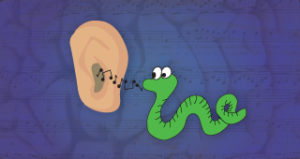Anatomy of an earworm
“Ooh, ah, give her your attention! Do I really need to mention?”
I glance at the red glowing clock dial on my dresser, never a wise idea. It’s 1:41 a.m. and a hard-working earworm has burrowed its way into my sleep/wake cycle. It must be getting close to concert time for the Outer Cape Chorale! With so many familiar songs in our latest program, the sound field is ripe for plunder. Some earworms are eerily relevant: “Four weeks, you rehearse and rehearse.” Others are just nonsensical: “to the pretty, pretty, pitter patter.” Some pump me up to greet the dawn: “It is the future that they bring when tomorrow comes.” Some have me stumbling over languages in the shower that make me want to jump out soaking wet and grab my music to remember those confounding syllables!
I’ve loved to sing since I was a kid, and my mom tells me that I would knock on doors in the neighborhood and ask people if I could sing for them. However, the last time I sang in a choir before OCC was in middle school. I never learned to sight read music, to my eternal regret. Although I never stopped singing privately and informally, I did not sing publicly throughout most of my adult life until my kids went off to college and some friends were putting together a pickup band for a church event. I heard myself volunteer to be the vocalist, and that was the beginning of my second wave of musical performance. Our band, “Red Beans and Rice,” morphed into the “house band” at our UU church in Philadelphia, until my husband (guitar and vocals) and I retired to Cape Cod.
When I learned that I could join the Outer Cape Chorale without necessarily needing to sight read, I was hopeful. I have a good ear, and can pick tunes up quickly. My first rehearsal was also Allison’s first time conducting us, and I could see right away that she was a very good teacher. Still, it was daunting, especially getting used to her piecemeal style of introducing us to the program. I was in awe of all the people around me who could just read the music and sing the notes. Nevertheless, between Allison’s practice CDs and the skilled singers around me, I learned to offer my voice up to the sound (and try not to sing at the wrong times)! And the joy of being part of 100+ humans singing in multi-part harmony was so worth the work I needed to put in!
So, getting back to my dear little earworms. Most definitions refer to “that pesky little tune that gets stuck in your hea d.” Apparently, they happen to 90% of people at least once a week. Who knew? According to researchers (yes, people actually research these things!), they often have psychological significance, triggering memories and emotional states. Oddly, though I am myself a psychologist, I am not really interested in the particular emotional significance of my OCC performance earworms. I know that they are time-limited, are meant to help me solidify my learning, and probably not hazardous to my health. In case of a particularly sticky one, I’ve also found that the time-honored cure of substituting another song works like a charm. So, my advice is to learn to love your earworms and when “the overture is about to start,” they will sit back and enjoy their handiwork. Happy singing!
d.” Apparently, they happen to 90% of people at least once a week. Who knew? According to researchers (yes, people actually research these things!), they often have psychological significance, triggering memories and emotional states. Oddly, though I am myself a psychologist, I am not really interested in the particular emotional significance of my OCC performance earworms. I know that they are time-limited, are meant to help me solidify my learning, and probably not hazardous to my health. In case of a particularly sticky one, I’ve also found that the time-honored cure of substituting another song works like a charm. So, my advice is to learn to love your earworms and when “the overture is about to start,” they will sit back and enjoy their handiwork. Happy singing!
– Maureen Osborne, Alto 2
